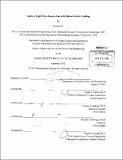Safety of light water reactor fuel with silicon carbide cladding
Author(s)
Lee, Youho
DownloadFull printable version (46.26Mb)
Other Contributors
Massachusetts Institute of Technology. Department of Nuclear Science and Engineering.
Advisor
Mujid S. Kazimi.
Terms of use
Metadata
Show full item recordAbstract
Structural aspects of the performance of light water reactor (LWR) fuel rod with triplex silicon carbide (SiC) cladding - an emerging option to replace the zirconium alloy cladding - are assessed. Its behavior under accident conditions is examined with an integrated approach of experiments, modeling, and simulation. High temperature (1100°C~1500°C) steam oxidation experiments demonstrated that the oxidation of monolithic SiC is about three orders of magnitude slower than that of zirconium alloys, and with a weaker impact on mechanical strength. This, along with the presence of the environmental barrier coating around the load carrying intermediate layer of SiC fiber composite, diminishes the importance of oxidation for cladding failure mechanisms. Thermal shock experiments showed strength retention for both [alpha]-SiC and [beta]-SiC, as well as A1₂O₃ samples quenched from temperatures up to 1260°C in saturated water. The initial heat transfer upon the solid - fluid contact in the quenching transient is found to be a controlling factor in the potential for brittle fracture. This implies that SiC would not fail by thermal shock induced fracture during the reflood phase of a loss of coolant accident, which includes fuel-cladding quenching by emergency coolant at saturation conditions. A thermo-mechanical model for stress distribution and Weibull statistical fracture of laminated SiC cladding during normal and accident conditions is developed. It is coupled to fuel rod performance code FRAPCON-3.4 (modified here for SiC) and RELAP-5 (to determine coolant conditions). It is concluded that a PWR fuel rod with SiC cladding can extend the fuel residence time in the core, while keeping the internal pressure level within the safety assurance limit during steady-state and loss of coolant accidents. Peak burnup of 93 MWD/kgU (10% central void in fuel pellets) at 74 months of in-core residence time is found achievable with conventional PWR fuel rod design, but with an extended plenum length (70 cm). An easier to manufacture, 30% larger SiC cladding thickness requires an improved thermal conductivity of the composite layer to reduce thermal stress levels under steady-state operation to avoid failure at the same burnup. A larger Weibull modulus of the SiC cladding improves chances of avoiding brittle failure.
Description
Thesis: Ph. D., Massachusetts Institute of Technology, Department of Nuclear Science and Engineering, 2013. Cataloged from PDF version of thesis. Includes bibliographical references (pages 303-314).
Date issued
2013Department
Massachusetts Institute of Technology. Department of Nuclear Science and EngineeringPublisher
Massachusetts Institute of Technology
Keywords
Nuclear Science and Engineering.